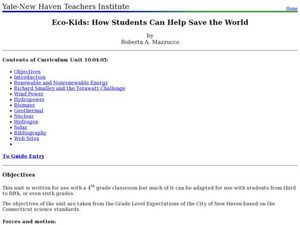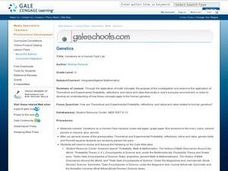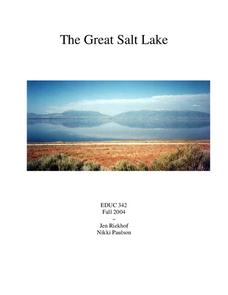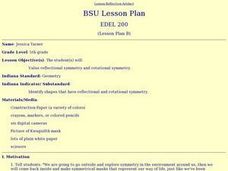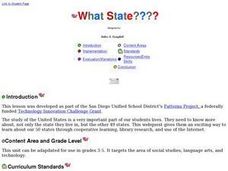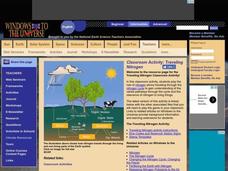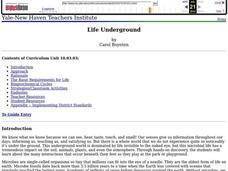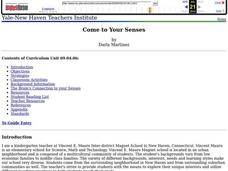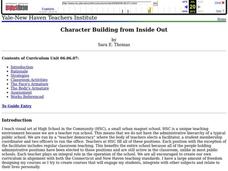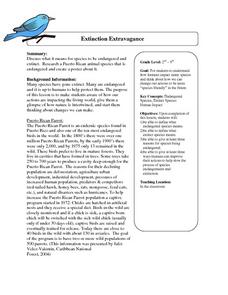Curated OER
Professor of Ice
In this environment experiment activity, students complete 3 experiments using ice. First they label each experiment and respond to the four questions given. Then students do the 3 experiments as stated, considering what the experiments...
Curated OER
"It's a Serious Game"
Students explore online safety by viewing an educational video. For this online identification lesson, students discuss the importance of keeping personal information private and when it is appropriate to enter personal information on...
Curated OER
Eco-Kids: How Students Can Help Save the World
Fourth graders identify the different types of renewable and nonrenewable energy sources. For this ecology lesson, 4th graders create models of wind mills and hydropower. They discuss the pros and cons of using alternative forms of energy.
Curated OER
Insect Conservation
Students make a diorama. In this insect lesson, students review what they know and what they need to know about insects. Students define conservation, discuss why it is important to conserve insects, and make an insect diorama.
Curated OER
Variations on a Human Face Lab
Ninth graders gain an application level understanding of probability, symmetry, and ratios and rates that exists in one's everyday environment relative to human genetics.
Curated OER
Cloud in a bag
Students relate the states of matter and clouds. In this environment lesson, students create a chart of information they know about clouds. Students put an ice cube in a bag and tape to a window. Students watch for...
Curated OER
Weather Tracking
Second graders use the internet to locate weather reports. They present data collected to the class through poster presentation. They read aloud the book Cloudy with a Chance of Meatballs by Judi Barrett and answer questions about...
Curated OER
Reflectional Symmetry And Rotational Symmetry
Fifth graders study reflectional symmetry and rotational symmetry. They go outside and explore symmetry in the environment. They come back inside and make symmetrical masks that represent their way of life.
Curated OER
What State????
Students study the United States. They research not only the state they live in, but the other 49 states. This webquest gives them an exciting way to study about our 50 states through cooperative learning, library research, and use of...
Curated OER
Dinosaurs
Students participate in a simulated archeological dig to gain an understanding of the earth's development as well as the organisms on it. In this dinosaur lesson plan, students work in small groups removing five pieces from the 'dig' one...
Curated OER
Echo, Echo, Echo, Each can help others
Learners discuss and research arguments about philanthropy. In this persuasive speech writing lesson, students choose a needed project for the community and present the reasons for the project through an original persuasive speech....
Curated OER
Traveling Nitrogen
Students act out the cycling of nitrogen through the environment. In this nutrient cycle instructional activity, students role play as nitrogen atoms traveling through the nitrogen cycle. They travel to stations and roll dice...
Curated OER
Forces and Motion Scavenger Hunt
Students determine how force on an object affects its movement. In this force and motion lesson, students take digital pictures of objects in the school setting that are pushed and pulled. They develop a presentation using the digital...
Curated OER
The Miracle Resource - From Forest to Products
Young scholars create a collage of wood products labeled by type of wood product. In this product engineering lesson, students work in groups to find pictures of solid wood products, engineered wood products, wood pulp, paper...
Curated OER
Cows, Worms and Compost
Third graders explore agriculture by viewing a PowerPoint presentation in class. In this animal relationship lesson, 3rd graders identify the types of farm animals humans feed on and their dependency on such small insects like worms....
Curated OER
Ecology
Students make connections between their daily lives and the usage of natural resources as they relate to the importance of environmental quality. In this ecology lesson, students listen to the story The Lorax by Dr. Seuss...
Curated OER
Life Underground
First graders build a terrarium in order to observe animal and plant life dynamics. In this biology lesson, 1st graders compare how organisms survive in different environments. They write their observations and analysis in their journal.
Curated OER
Come to Your Senses
Students explore their senses. In this biology lesson plan, students will learn about their senses, what affects them, and how the brain works to control our senses in a series of lab activities.
Curated OER
Character Building from Inside Out
Students relate the facial muscle location with a person's expressions. In this visual arts lesson, students write a fictional story about a character. They use digital cameras and computer softwares to create an animation film about it.
Curated OER
Machines: Designing Form and Function
Students design a boat model with simplified steam engine. For this ecology lesson, students compare renewable and nonrenewable energy sources. They determine the efficiency of their boat model.
Curated OER
Extinction Extravagance
Learners brainstorm and discuss what it means for a species to be considered endangered and/or extinct. They research animals in Puerto Rico and choose one that is considered endangered and create a poster about it. In addition, they...
Curated OER
Gifts from the Sea
Students investigate parts of the ocean. In this seaweed lesson, students identify foods that contain seaweed, parts of seaweed, and how the ocean affects our lives. As a class students brainstorm ways we rely on the ocean and compare...
Curated OER
Start at the Very Beginning
Students explore ocean ecosystems. In this cross curriculum art and oceans lesson, students create a collage featuring three-finger algae using sand paper, tissue paper, and construction paper.
Curated OER
Understanding Human Population Growth
You can help students learn about the causes and consequences of our rapidly growing global population


